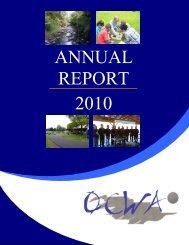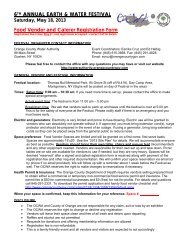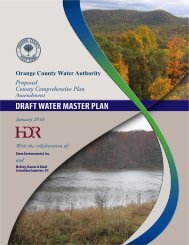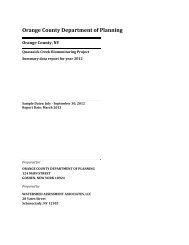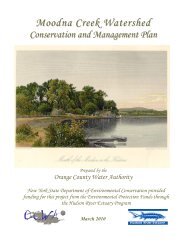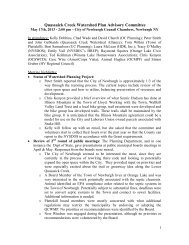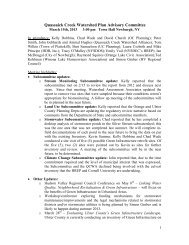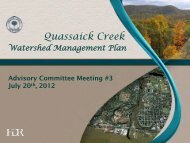Biodiversity of the Moodna Creek Watershed - Orange County Water ...
Biodiversity of the Moodna Creek Watershed - Orange County Water ...
Biodiversity of the Moodna Creek Watershed - Orange County Water ...
You also want an ePaper? Increase the reach of your titles
YUMPU automatically turns print PDFs into web optimized ePapers that Google loves.
<strong>Moodna</strong> <strong>Biodiversity</strong><br />
L. Heady, 19 June 2008 DRAFT<br />
used as foraging habitat by turtles, snakes, frogs, wood ducks, bats, and o<strong>the</strong>r wildlife.<br />
Because <strong>of</strong> <strong>the</strong>ir small size and isolation, woodland pools lack Federal or State<br />
protection, and consequently are <strong>of</strong>ten overlooked, filled, or drained. In instances where<br />
pools receive local protection, <strong>the</strong> protected adjacent area or “buffer” is typically<br />
inadequate. In order to sustain populations <strong>of</strong> pool-breeding amphibians, substantial<br />
forested habitat in <strong>the</strong> surrounding area must be protected. Calhoun and Klemens (2002)<br />
recommend maintaining forested buffers <strong>of</strong> 750 feet around pools, with less than 25%<br />
development or disturbance in <strong>the</strong> forested zone. While Black Rock Forest is known to<br />
have many woodland pools, and pool locations were documented in MCA’s Sou<strong>the</strong>rn<br />
Wallkill <strong>Biodiversity</strong> Plan (Miller et al. 2005), distribution <strong>of</strong> this habitat on private lands<br />
is relatively unknown or undocumented for <strong>the</strong> watershed and requires fur<strong>the</strong>r study.<br />
Threats and Conservation Opportunities<br />
• Wetland habitat mapping. <strong><strong>Water</strong>shed</strong> communities will be better equipped to make<br />
land-use decisions if higher-quality wetland maps are available. One method to obtain<br />
such information is to create town-scale wetland maps; although this process can be<br />
costly, volunteers can be engaged to assist with appropriate components (see below).<br />
These maps can be part <strong>of</strong> a comprehensive natural resource inventory (NRI), and can<br />
represent different wetland habitat types (e.g., hardwood swamp, emergent marsh, etc.);<br />
include wetlands <strong>of</strong> all sizes, with no minimum area; and designate zones with varying<br />
degrees <strong>of</strong> conservation need. In <strong>the</strong>se zones, regulated buffer sizes could be adjusted to<br />
meet specific goals; for example, maintaining water quality in an urbanized area versus<br />
protecting important habitat for a rare species. In <strong>the</strong> absence <strong>of</strong> a town-scale map, at a<br />
minimum, NYS Freshwater Wetland (including 2008 amendments for <strong>Orange</strong> <strong>County</strong>),<br />
NWI, and hydric soil data can be compiled into a GIS project as a baseline that can<br />
eventually be enhanced by detailed remote sensing and field investigations. Wetland<br />
buffers <strong>of</strong> at least 150 ft (50 m) can be added as important adjacent area. When setting<br />
conservation priorities, special attention can be given to large wetland complexes, and<br />
clusters <strong>of</strong> small or medium size wetlands. Larger buffer sizes can be added if local<br />
conditions or conservation needs are known (e.g., forested buffers <strong>of</strong> 750 ft [250 m] are<br />
recommended for woodland pools.)<br />
• Citizen science. Citizen scientists and volunteers can be engaged in mapping <strong>of</strong> locallyimportant<br />
wetlands. For example, a partnership with <strong>the</strong> Hudson River Estuary Program<br />
can be pursued to develop a map <strong>of</strong> woodland pools in <strong>the</strong> watershed. In addition,<br />
biodiversity assessment training is available to municipalities from Hudsonia Ltd. on<br />
identification and mapping <strong>of</strong> ecologically-significant habitats; this habitat approach can<br />
be part <strong>of</strong> an NRI process.<br />
• Local ordinances. Municipalities can pursue creation <strong>of</strong> local wetland ordinances, to<br />
ensure that wetlands and buffer areas that are inadequately protected by existing state and<br />
federal regulations no longer fall through regulatory cracks. Such ordinances can ensure<br />
protection <strong>of</strong> important community resources, while assisting decision-making boards<br />
and landowners in identifying conservation priorities early in <strong>the</strong> planning process.<br />
• Amphibian and reptile habitat complexes. The <strong>Moodna</strong> watershed has an extremely<br />
rich diversity <strong>of</strong> amphibians and reptiles, many <strong>of</strong> which are increasingly rare. These<br />
species <strong>of</strong>ten require habitat complexes for survival, so maintaining landscape<br />
connectivity is extremely important. (Mitchell et al. 2006) For example, within New<br />
York, <strong>the</strong> imperiled nor<strong>the</strong>rn cricket frog is known to migrate at least 750 ft (250 m) from<br />
17



